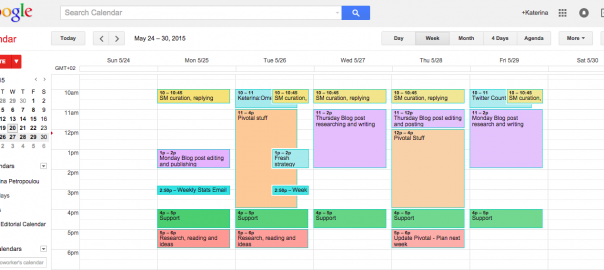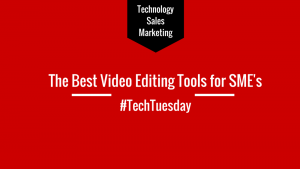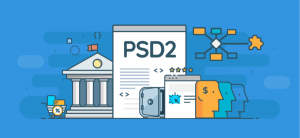Social media is a magical place. But just like Alice in Wonderland, this magical world has certain challenges in store for social media managers.
How do you juggle different tasks during the day? How do you cope with new tools and platforms popping up everyday or your boss telling you “We should be on Snapchat ’cause it’s cool!”?
This short survival guide is meant to help you stay focused on what matters the most, get organized and all around keep your sanity when it comes to managing social media.
Set goals
Before you take any action on social media, you need to define clearly your goals and objectives in order to set a solid base for a social media strategy.
Your social media marketing goals should be aligned with your overall business strategy simply because social media is an important marketing tool with a great potential for helping you achieve your business goals.
I know, this sounds intimidating. But trust me; it becomes much easier once you follow the SMART approach for setting up your social media marketing goals.

Pick your battles
Being on a platform simply ’cause “it’s cool” doesn’t cut it. Among other factors you need to consider whether maintaining an active social media presence on each platform serves your marketing goals or simply whether or not your audience is using it.
A recent study by Hubspot revealed that most consumers expect you to be active on all social media platforms, and especially Facebook and Twitter. In fact, millennials expect brands to be active on at least four platforms. But despite these expectations, the same audience is most likely to follow you only on half of these platforms.

But the fact that there’s a bunch of social media platforms out there doesn’t mean that you need to be present on each of them. It makes much more sense to focus most of our efforts on the social platforms that make sense to you and are likely to generate the most impact.
The platforms that are more likely to have the biggest impact for your business are the ones that your audience is using and that are relevant to your product or service. If for example you’re a local retailer, a platform like Google+ is less likely to prove impactful for your brand so there’s no need to invest any time and effort on building your presence there, as your ROI will be relatively low.
A good way to decide where your time will have the most impact is running a super quick social media audit. Here’s how it works:
Step 1: List all the platforms you are active on with links to your social media profiles.
Step 2: Update any imagery and profile description that needs to be updated.
Step 3: Check some key metrics such as audience growth, reach, engagement and traffic generated from this platform.
Step 4: Evaluate your presence on each social media platform by checking your KPIs. This process will help you gain some perspective and assess where you should focus your efforts from now on.

Another way to make better use of your time is making a division between high frequency and low frequency platforms. For example, as a rule of thumb, Twitter is a higher frequency platform which means that it requires a higher number of posts. Facebook, Instagram, LinkedIn on the other hand, could be considered lower frequency platforms with the volume varying from one to two posts a day to one to two posts per week.
Of course this division comes down to your own social media strategy, how you’ve chosen to manage social media and the goals you have set for each platform depending on your audience. Making such a plan however, can provide you with a better perspective on allocating your time and placing your efforts where you need to.
Having an idea of how much time you need to invest on each platform will help you to organize your tactics and divide your time more efficiently.

Organize yourself
Visualizing your daily tasks always helps. This way, you see how you spend your time juggling social media management and other tasks and distribute your time in a better way. There are many tools to help you out but what I’ve found the handiest is Google Calendar since I can have meetings and tasks all in one place for a better overview and more importantly, I can easily modify my tasks and events to better plan my week.

But there’s more to it!
Use a Social Media Content Calendar
What should I post next? I’m sure that you’ve asked yourself this question at some point. If you are active on more than one social platforms you often could struggle with content creation as it takes up most of your time. So how can you organize the way you deliver content? That’s right, with a social media calendar! Having a social media calendar not only can save you a ton of time but it also allows you to better plan ahead around significant dates.

Benefit from Twitter lists
The fact that you can add any Twitter user to a list whether you follow them or not, gives you endless possibilities. Here’s just few of the reasons why Twitter lists are an essential tool for your Social Media strategy. Twitter lists can help you:
1. Listen
Having a good monitoring system in place is one of the most important elements of a good social media strategy and Twitter lists can make Twitter monitoring much easier.
For example, creating a private list of your competitors can help you get a better idea of their Twitter strategy and get some inspiration on what you could improve in your tweeting.
2. Build relationships
Twitter lists is what Monica Geller would refer to as ‘organized fun’. You can use them to build Twitter relationships with influencers in your field and reach out to new people in your niche. This way, you can build authority and a strong community around your brand in a more efficient way.
3. Curate content
Twitter lists are a great way to keep up with all that’s happening in real time and curate content you can share with your followers. For example, you can keep up to date with all the latest from social media influencers or influencers in your industry.
Maximize impact, minimize effort
Managing social media can be a tedious and time-consuming task. In addition, managing social media for an SMB involves a lot of different tasks like engaging with your audience, building a community, posting and curating content.
Take a look at this break-down of time-saving social media management tools for maximum impact and minimum time spent.
1. Content Curation
Using keywords and interests Scoop.it can turn into a powerful, tailor made content curation tool with the option to directly publish content on social media in one click.
Feedly
Feedly is basically a news aggregator that can pull any RSS feed. You can completely personalize your experience and add all your favorite news sources and blogs into a stream so that every day you can immediately find great articles in your niche to share. Feedly also shows the number of shares for each piece which is a great way to quickly grasp the social media buzz around a topic.
Flipboard is a magazine-like mobile app for smart content curation on the fly that can save you a ton of time, as you can discover amazing content to share during your morning commute.
Bonus:
StartAFire is not a tool that will help you curate content but it’s definitely a tool that will help you add even more value to the content you share on social media. It’s currently in beta, but you can request an invitation. It integrates with Buffer scheduler and basically allows you to seamlessly promote your own content with great click through rates. So every time you share a link from a third source, StartAfire adds a little modal with content suggestions from you.

2. Content creation
Canva
Canva is a great tool for creating professional looking images for social media in less than 3 minutes. The best part is that you shouldn’t worry about the size of your images since Canva offers templates of visuals for all major platforms.
Piktochart is great for creating infographics in just a few minutes. What is helpful is the wide range of themes to choose from and the freedom the tool offers in customizing templates to fit your style and needs.
Wideo is a handy tool for creating videos for social media, quickly and easily. The free version allows you to choose from a selection of templates and produce videos up to 45 seconds which is the ideal length for a social media post.
3. Posting and scheduling
Twibble is a cool tool that will automatically post your blog posts on Twitter with amazing visuals to go with. All you need to do is set up the RSS feed and specify how often you want to tweet, hashtags and attributions. Twibble then will start scanning your source for blog posts and automatically post them to your Twitter feed using the posts featured image.
Buffer is one of the most popular schedulers for social media and for a good reason. A few months ago, buffer integrated Pinterest which is a big plus and which means that buffer now supports all the major social media platforms with the exception of Instagram. You can either let Buffer suggest you times to tweet or set up your own custom content schedule.
Although it started as a Google+ tool, Friends+me is a good alternative to Buffer that allows you to schedule content from anywhere on the internet.
Measure
Every social media manager knows that analyzing and testing your social media activity can make things much easier in the long run.
It might come as a surprise, but a recent survey revealed that only 15% of brands are able to quantify the impact of social media on their business.
So how are you going to determine whether your social media efforts are actually making a difference for your business? What key measures will you use to evaluate social media strategy effectiveness?
This infographic that surfaced a few years back, reveals what KPIs social media marketers focus on to quantify the impact of social media marketing on their business.
For example, if your social media marketing goal is to increase conversions through social media, which let’s just face it, is the ultimate goal for any brand on social, then using Google Analytics, you can track all conversions throughout platforms by checking the Conversions report under Acquisitions > Social.
Convince and Convert have put together a great guide of top Google Analytics reports every social media marketer should keep an eye on that cover different goals and KPIs. Check it out.
Avinash Kaushik is suggesting among others, three main metrics:
- Conversation rate, in other words how much conversation your brand stirs on social media.
- Amplification rate, how much your message is being shared and what is its reach.
- Applause rate which is how much minimal interaction (favorites, likes and +1s) your content receives on social media.
These groups of metrics point to social media exposure which translates to brand awareness, brand influence, engagement and leads or sales.
So don’t let anyone tell you that time and resources spent on social media might be better spent elsewhere. Social media can not only help you build awareness for your brand but also establish yourself as a thought leader in your field and ultimately generate leads.
In fact, a recent research conducted by LinkedIn revealed that:
- 81% of SMBs currently use social media to drive business growth and 9% are planning to use it in the future.
- 3 in 5 SMBs say it helps to gain new customers.
- 91% of hyper growth SMBs say it is effective for increasing awareness and 82% for generating new leads – which is more than 58% higher than the stated effectiveness for non-growth companies.
And although social media may not be necessarily a short cut, it can definitely become a marketing power tool in your hands.
Digital & Social Articles on Business 2 Community
(171)










